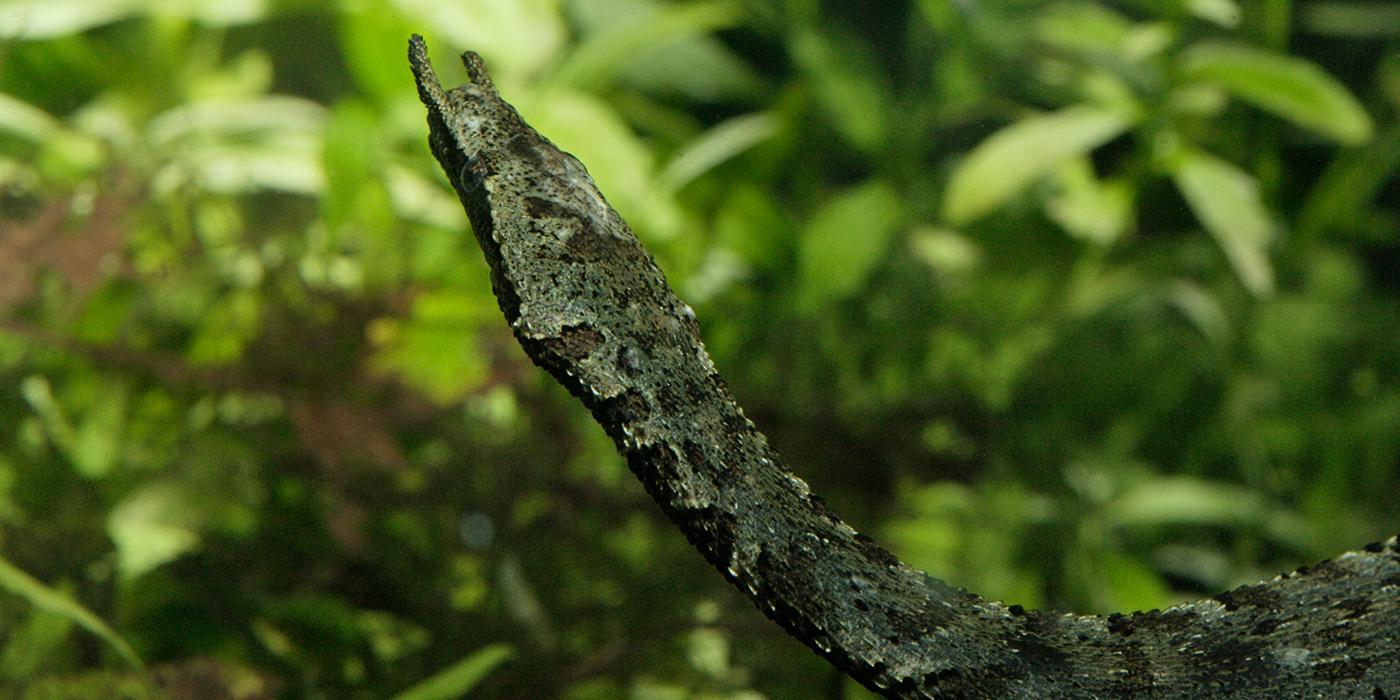Physical Description
This distinctive snake's most identifiable characteristic is the pair of scaly appendages that project from its snout. Its head and body are extremely flat, and its coloring varies from light brown with dark stripes to dark gray with light-brown mottling. This color and pattern can resemble a twig or branch with mottled, water-soaked bark. The snake's scales are keeled and feel rough like sandpaper.
Tentacled snakes are diurnal and aquatic. They are nearly helpless on land and almost never leave the water voluntarily. Underwater, they rely on their cryptic pattern and coloring for camouflage to avoid predators. If investigated by an approaching animal, the tentacled snake extends its body, becoming completely rigid. It maintains this position even if removed from the water, which further enhances its ability to resemble a water-soaked branch.
This snake's nostrils are dorsally positioned and valvular — specialized tissue allows them to close. Adjacent to the nostrils are the snake's two short, scaly tentacles. The purpose of these appendages is not known with certainty, but it's possible they act as a lure to attract prey, a device for locating prey and/or a tool for camouflage.
Size
The tentacled snake averages a length of 50 centimeters (about 19.6 inches).
Native Habitat
Tentacled snakes are found in coastal Southeast Asia, including Vietnam, Thailand and Cambodia. They inhabit fresh or brackish water, streams, ditches, sloughs and rice paddies, and are typically found in slow-moving or stagnant bodies of water with vegetation at or just below the water line. During the dry season, these snakes have been observed burying themselves in the mud until the rainy season returns.
Communication
Tentacled snakes do not vocalize, but their visual and sensory perception systems appear to be integrated. Their highly sensitive tentacles detect the presence of other animals. The nerves connecting the snake's tentacles to its brain input information to the region that receives optic signals, so these snakes use both their sense of touch and vision to perceive their surroundings.
Food/Eating Habits
Tentacled snakes feed almost exclusively on fish but have also been observed eating frogs and, in some cases, crabs. They are rear-fanged, and various species seem to have specialized venom for their preferred prey.
This ambush predator lies still among submerged vegetation throughout the day waiting for prey. Its unique hunting strategy involves herding prey into position, so it's easy to capture. As a potential meal approaches, the snake "bumps" out part of its body creating a bow wave in the direction of the passing prey. The resulting wave causes the fish to change direction, usually heading directly into the jaws of the snake. The initial bump of the snake's body is so quick that it requires high-speed film to observe.
Reproduction and Development
This species is viviparous, meaning it bears live young. The young snakes feed exclusively on small fish.
Conservation Efforts
Tentacled snakes sometimes appear in the pet trade and have often been wild-caught. Additionally, some emerging fungal diseases of reptiles that have been observed in tentacled snakes.
Their wetland habitats are often used for rice farming and other aquaculture, which can put a greater strain on this species and others that rely on the same habitats.
Help this Species
Choose your pets wisely, and do your research before bringing an animal home. Exotic animals don’t always make great pets. Many require special care and live for a long time. Tropical reptiles and small mammals are often traded internationally and may be victims of the illegal pet trade. Never release animals that have been kept as pets into the wild.
Share the story of this animal with others. Simply raising awareness about this species can contribute to its overall protection.
Less is more. Cut down on the demand for resources by consuming less. Buy only what you need, and look for pre-owned or repurposed items before purchasing something brand new.
Smithsonian's National Zoo and Conservation Biology Institute. (n.d.). Tentacled snake. Retrieved October 20, 2025, from https://nationalzoo.si.edu/animals/tentacled-snake
Animal News

7 Spooktacular Animal Facts for Halloween ›

Meet the Orangutans Living at the Smithsonian’s National Zoo ›

